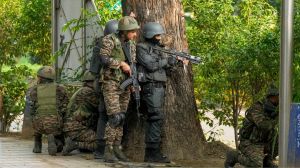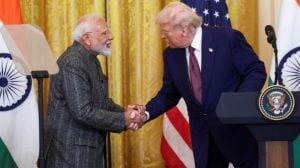PGI performs India’s first robot-assisted male infertility surgery
The patient, a 43-year-old man, presented with secondary infertility due to vasectomy and was discharged the next day following surgery.
 Mohan added that the case demonstrates the versatility of robotic systems beyond cancer surgeries and reconstructive procedures. “It sets the stage for broader applications in andrology and microsurgery,” he added.
Mohan added that the case demonstrates the versatility of robotic systems beyond cancer surgeries and reconstructive procedures. “It sets the stage for broader applications in andrology and microsurgery,” he added.
In a significant milestone, doctors at the PGIMER Chandigarh have successfully performed India’s first robot-assisted vasovasostomy on Wednesday. This pioneering procedure, which was done by Dr Aditya Prakash Sharma, Dr Girdhar Bora, and Dr Ravi Mohan from the Department of Urology, offers a modern alternative to the conventional microscope-based technique used in male infertility surgery.
The patient, a 43-year-old man, presented with secondary infertility due to vasectomy and was discharged the next day following surgery.
Vasovasostomy, or vasectomy reversal, is a delicate microsurgical procedure that reconnects the severed ends of the vas deferens to restore fertility. Traditionally performed using an operating microscope, this case marked a paradigm shift as the surgery was conducted using the Da Vinci surgical system, providing enhanced precision, stability, and three-dimensional magnified visualisation, the institute said.
Vasovasostomy is a procedure in which after a vasectomy, the blocked tubes are reconnected to restore fertility in men. Conventionally, it is done using magnification under an operating microscope. Robot-assisted vasovasostomy is a modern technique in which, instead of using a microscope, the surgeon uses a robot to join the tiny sperm-carrying tubes with great precision. This technique improves accuracy and increases the chances of a successful outcome.
“This innovation reflects the PGIMER’s commitment to bringing cutting-edge technology into clinical practice. Robot-assisted vasovasostomy allows for meticulous suturing using extremely thin sutures (thinner than the diameter of human hair), while reducing surgeon fatigue and tremor,” Sharma said. “Robot-assisted vasovasostomy not only expands the scope of robotic surgery in andrology but also opens new hope for couples seeking natural conception after vasectomy.”
Mohan added that the case demonstrates the versatility of robotic systems beyond cancer surgeries and reconstructive procedures. “It sets the stage for broader applications in andrology and microsurgery,” he added.
With this achievement, the PGIMER joins a small group of global centres that have performed robot-assisted vasovasostomy, placing India on the map in this advanced domain. The surgical team plans to publish their experience in peer-reviewed literature, paving the way for larger clinical applications.












